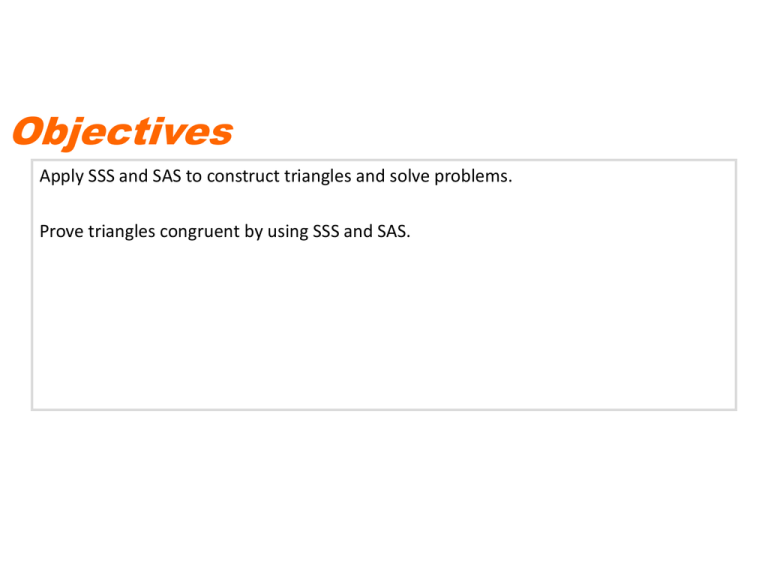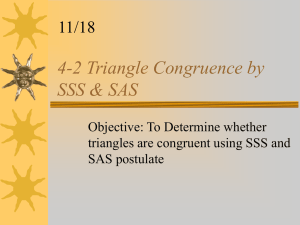Triangle Congruence Postulates
advertisement

Objectives Apply SSS and SAS to construct triangles and solve problems. Prove triangles congruent by using SSS and SAS. For example, you only need to know that two triangles have three pairs of congruent corresponding sides. This can be expressed as the following postulate. Remember! Adjacent triangles share a side, so you can apply the Reflexive Property to get a pair of congruent parts. Example 1: Using SSS to Prove Triangle Congruence Use SSS to explain why ∆ABC ∆DBC. It is given that AC DC and that AB DB. By the Reflexive Property of Congruence, BC BC. Therefore ∆ABC ∆DBC by SSS. Check It Out! Example 1 Use SSS to explain why ∆ABC ∆CDA. It is given that AB CD and BC DA. By the Reflexive Property of Congruence, AC CA. So ∆ABC ∆CDA by SSS. An included angle is an angle formed by two adjacent sides of a polygon. B is the included angle between sides AB and BC. Caution The letters SAS are written in that order because the congruent angles must be between pairs of congruent corresponding sides. Example 2: Engineering Application The diagram shows part of the support structure for a tower. Use SAS to explain why ∆XYZ ∆VWZ. It is given that XZ VZ and that YZ WZ. By the Vertical s Theorem. XZY VZW. Therefore ∆XYZ ∆VWZ by SAS. Check It Out! Example 2 Use SAS to explain why ∆ABC ∆DBC. It is given that BA BD and ABC DBC. By the Reflexive Property of , BC BC. So ∆ABC ∆DBC by SAS. Objectives Apply ASA, AAS, and HL to construct triangles and to solve problems. Prove triangles congruent by using ASA, AAS, and HL. An included side is the common side of two consecutive angles in a polygon. The following postulate uses the idea of an included side. included side Vocabulary Methods to Establish Component Congruence, when congruence is not given 1.If a segment is bisected, you have two congruent segments 2. If a midpoint is given you have two congruent segments 3. If you have vertical angles you have two congruent angles. 4. If you are given an angle bisector, you have two congruent angles. 5. If you have parallel lines cut by a transversal, the alternate interior angle are congruent. 6. If you have a perpendicular line, there are two congruent 90 degree angles. 7. If you are given a perpendicular bisectors, you have 4 congruent angles and two congruent segments. 8. A common or shared side is considered a set of congruent sides. 9. A common or shared angle is considered a set of congruent angles. Check It Out! Example 2 Determine if you can use ASA to prove NKL LMN. Explain. By the Alternate Interior Angles Theorem. KLN MNL. NL LN by the Reflexive Property. No other congruence relationships can be determined, so ASA cannot be applied. You can use the Third Angles Theorem to prove another congruence relationship based on ASA. This theorem is AngleAngle-Side (AAS). Example 3: Using AAS to Prove Triangles Congruent Use AAS to prove the triangles congruent. Given: X V, YZW YWZ, XY VY Prove: XYZ VYW Check It Out! Example 3 Use AAS to prove the triangles congruent. Given: JL bisects KLM, K M Prove: JKL JML Example 4A: Applying HL Congruence Determine if you can use the HL Congruence Theorem to prove the triangles congruent. If not, tell what else you need to know. According to the diagram, the triangles are right triangles that share one leg. It is given that the hypotenuses are congruent, therefore the triangles are congruent by HL. Check It Out! Example 4 Determine if you can use the HL Congruence Theorem to prove ABC DCB. If not, tell what else you need to know. Yes; it is given that AC DB. BC CB by the Reflexive Property of Congruence. Since ABC and DCB are right angles, ABC and DCB are right triangles. ABC DCB by HL.


